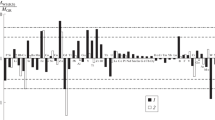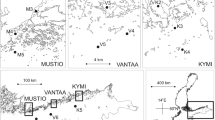Abstract
Offshore fluxes of Cu, Zn, Cd, Pb and Hg were calculated based on residual flow patterns and salinity gradients along the Belgian coast. The residual flow lines along the Belgian coast are more or less parallel to the coast except in the area where the north-easterly flowing watermass coming from the Channel encounters the south-westerly-oriented Scheldt outflow, forming a residual hydrodynamical front. From the steady-state salinity pattern, diffusion coefficients perpendicular to the residual flow were deduced; they ranged from 21 to 108 m2 s−1.
Offshore fluxes of dissolved and particulate trace metals based on diffusive and mixing processes are calculated. The steady state profiles of dissolved metals show a dilution effect in the coastal waters, reaching an almost constant concentration in the marine watermass in the 1981–1983 dataset. The ratios of the Scheldt input of trace metals to the total dissolved offshore flux vary from 38 to 55% (1981–1983), depending on the kind of metal, and from 55 to 91% (1995–1996). The ratio of the Scheldt input to the dissolved metal flow parallel to the coast, is in both periods (1981–1983 and 1995–1996), smaller than 1%. The steady-state concentration profiles of particular metals versus salinity are fairly constant in the coastal-estuarine and marine watermasses, but decrease very abruptly from the first to the second watermass. Assuming a conservative behaviour of the particular metals, offshore fluxes and the resulting concentration increases agree fairly well with the observed values. The ratios of the Scheldt input to the particulate trace metal offshore flux vary between 30 to 46% (1981–1983) and 13 to 37% (1995–1996). The contribution of the Scheldt estuary to the flows parallel to the coast ranges from 1.6 to 2.9% (1981–1983) and from 0.6 to 1.6% (1995).
Access this chapter
Tax calculation will be finalised at checkout
Purchases are for personal use only
Preview
Unable to display preview. Download preview PDF.
Similar content being viewed by others
References
Adam, Y., W. Baeyens, J. P. Mommaerts & G. Pichot, 1981. Mathematical modelling of recent sedimentology in the shallow waters along the Belgian coast. In J. C. J. Nihoul (ed.), Ecohydrodynamics. Elsevier, Amsterdam: 333–349.
Baeyens, W., G. Gillain, G. Decadt & T. Elskens, 1987. Trace metals in the eastern part of the North Sea. I. Analyses and short term distributions. Oceanol. Acta 10: 169–179.
Bacyens, W., M. Elskens, G. Gillain & L. Goeyens 1998a. Biogeochemical behaviour of Cd, Cu, Pb and Zn in the Scheldt estuary during the period 1981–1983. Hydrobiologia 366: 15–44.
Baeyens, W., K. Parmentier, L. Goeyens, G. Ducastel, M. De Gieter & M. Leermakers 1998b. The biogeochemical behaviour of Cd, Cu, Pb and Zn in the Scheldt estuary: results of the 1995 surveys, Hydrobiologia 366: 45–62.
Baeyens, W., C. Meuleman & B. Muhaya & M. Leermakers 1998c. Behaviour and speciation of mercury in the Scheldt estuary (water, sediments and benthic organisms). Hydrobiologia 366: 63–79.
Baeyens, W., F. Monteny, R. Van Ryssen & M. Leermakers, 1998d. A box-model of metal flows through the Scheldt estuary (19811983 and 1992–1995). Hydrobiologia 366: 109–128.
Burton, J., M. Althaus, G. Millward, A. Morris, P. Statham, A. Tappin & A. Turner, 1993. Processes influencing the fate of trace metals in the North Sea. Phil. Trans. r. Soc. A. 343: 557–568.
Coquery, M. & D. Cossa, 1995. Mercury concentrations in surface waters of the North Sea, Neth. J. Sea Res. 34: 245–257.
Cossa, D., J. Sanjuan & J. Noel, 1994. Mercury transport in waters of the Strait of Dover, Mar. Pollut. Bull. 28: 385–388.
Djenidi, S. & F. Ronday, 1985. Tidal and residual circulation on the North-European continental shelf. In R. Van Grieken & R. Wollast (eds), Progress in Belgian oceanographic research. The Belgian Academy of Sciences, Committee of Oceanology, Brussels: 46–59.
Duinker, J. C. & R. F. Nolting, 1982. Dissolved copper, zinc and cadmium in the Southern Bight of the North Sea. Mar. Pollut. Bull. 13: 93–96.
McDowell D. M. & B. A. O’Connor, 1977. Hydraulic Behaviour of Estuaries. The MacMillan Press Ltd., London, 292 pp.
Mommaerts, J. P., G. Pichot, J. Ozer, Y. Adam & W. Baeyens, 1984. Nitrogen cycling and budget in Belgian coastal waters North Sea areas with and without river inputs. Rapp. Pv. Reun. Cons. Int. Explor. Mer 183: 57–69.
Nihoul J. C. J., 1975. Hydrodynamic models. In J. C. J. Nihoul (ed.), Modelling of Marine Systems, Elsevier Scientific Publishing Company, Amsterdam, 272 pp.
Nihoul. J. C. J. & F. Ronday, 1976. Hydrodynamic models of the North Sea. Mem. Soc. Sci. Lg. 10: 61–96.
Nihoul, J. C. J., 1980. Residual circulation, long waves and mesoscale eddies in the North Sea. Oceanol. Acta 3: 309–316.
OSPAR/ICES, 1997. Workshop on the overall evaluation and update of background/reference concentrations for nutrients and for contaminants in sea water, biota and sediments, Oslo and Paris Commissions, Report SIME, 97/7/2, 60 pp.
Prandle, D., G. Ballard, D. Flatt, A. Harrison, S. Jones, P. Knoght, S. Loch, J. McManus, R. Player & A. Tappin, 1996. Combining modelling and monitoring to determine fluxes of water, dissolved and particulate metals through the Dover Strait. Cont. Shelf Res. 16: 237–257.
Ronday, F., 1976. Modeles hydrodynamiques. In J. C. J. Nihoul & F. C. Ronday (eds), Projet Mer, Rapport Final, 3. Services du Premier Ministre, Programmation de la Politique Scientifique, Brussels, 270 pp.
Statham P. J., Y. Auger, J. Burton, P. Choisy, J-C. Fischer, R. James, N. Morley, B. Oudane, E. Puskaric, M. Wartel, 1993. Fluxes of Cd, Co, Cu, Fe, Mn, Ni, Pb and Zn through the Strait of Dover into the Southern North Sea. Oceanol. Acta 16: 541–552.
Topping, G., J. M. Bewers & P. G. W. Jones, 1980. A review of the past and present measurements of selected trace metals in sea water in the Oslo Commission and ICNAF (NAFO) areas. Coop. Res. Rep., 97. I.C.E.S., Copenhague, 43 pp.
Wollast, R., 1976. Proprietes physico-chimiques des sediments et des suspensions de la mer du Nord. In J. C. J. Nihoul & F. Gullentops (eds), Sedimentologie, Projet Mer, Rapport Final, 4. Services du Premier Ministre, Programmation de la Politique Scientifique, Brussels: 123–143.
Author information
Authors and Affiliations
Editor information
Rights and permissions
Copyright information
© 1998 Springer Science+Business Media Dordrecht
About this chapter
Cite this chapter
Baeyens, W., Elskens, M., Van Ryssen, R., Leermakers, M. (1998). The impact of the Scheldt input on the trace metal distribution in the Belgian coastal area (results of 1981–1983 and 1995–1996). In: Baeyens, W.F.J. (eds) Trace Metals in the Westerschelde Estuary: A Case-Study of a Polluted, Partially Anoxic Estuary. Developments in Hydrobiology, vol 128. Springer, Dordrecht. https://doi.org/10.1007/978-94-017-3573-5_6
Download citation
DOI: https://doi.org/10.1007/978-94-017-3573-5_6
Publisher Name: Springer, Dordrecht
Print ISBN: 978-90-481-5062-5
Online ISBN: 978-94-017-3573-5
eBook Packages: Springer Book Archive




